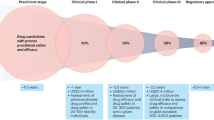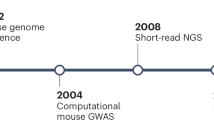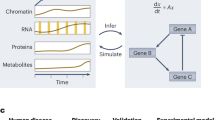Abstract
Experimental animal models are essential to obtain basic knowledge of the underlying biological mechanisms in human diseases. Here, we review major contributions to biomedical research and discoveries that were obtained in the mouse model by using forward genetics approaches and that provided key insights into the biology of human diseases and paved the way for the development of novel therapeutic approaches.
Similar content being viewed by others
Log in or create a free account to read this content
Gain free access to this article, as well as selected content from this journal and more on nature.com
or
References
Seok J, Warren HS, Cuenca AG et al: Genomic responses in mouse models poorly mimic human inflammatory diseases. Proc Natl Acad Sci USA 2013; 110: 3507–3512.
Schughart K : SYSGENET: a meeting report from a new European network for systems genetics. Mamm Genome 2010; 21: 331–336.
Snell GD : Studies in histocompatibility. Science 1981; 213: 172–178.
Kohler G, Howe SC, Milstein C : Fusion between immunoglobulin-secreting and nonsecreting myeloma cell lines. Eur J Immunol 1976; 6: 292–295.
Kohler G, Milstein C : Derivation of specific antibody-producing tissue culture and tumor lines by cell fusion. Eur J Immunol 1976; 6: 511–519.
Peirce JL, Lu L, Gu J, Silver LM, Williams RW : A new set of BXD recombinant inbred lines from advanced intercross populations in mice. BMC Genet 2004; 5: 7.
Taylor BA, Wnek C, Kotlus BS, Roeme rN, MacTaggart T, Phillips SJ : Genotyping new BXD recombinant inbred mouse strains and comparison of BXD and consensus maps. Mamm Genome 1999; 10: 335–348.
Collaborative Cross Consortium: The genome architecture of the collaborative cross mouse genetic reference population. Genetics 2012; 190: 389–401.
Kelada SN, Aylor DL, Peck BC et al: Genetic analysis of hematological parameters in incipient lines of the collaborative cross. G3 (Bethesda) 2012; 2: 157–165.
Bottomly D, Ferris MT, Aicher LD et al: Expression quantitative trait loci for extreme host response to influenza a in pre-collaborative cross mice. G3 (Bethesda) 2012; 2: 213–221.
Aylor DL, Valdar W, Foulds-Mathes W et al: Genetic analysis of complex traits in the emerging Collaborative Cross. Genome Res 2011; 21: 1213–1222.
Durrant C, Tayem H, Yalcin B et al: Collaborative Cross mice and their power to map host susceptibility to Aspergillus fumigatus infection. Genome Res 2011; 21: 1239–1248.
Philip VM, Sokoloff G, Ackert-Bicknell CL et al: Genetic analysis in the Collaborative Cross breeding population. Genome Res 2011; 21: 1223–1238.
Nolan PM, Hugill A, Cox RD : ENU mutagenesis in the mouse: application to human genetic disease. Brief Funct Genomic Proteomic 2002; 1: 278–289.
Cox RD, Brown SD : Rodent models of genetic disease. Curr Opin Genet Dev 2003; 13: 278–283.
Beier DR, Herron BJ : Genetic mapping and ENU mutagenesis. Genetica 2004; 122: 65–69.
Clark AT, Goldowitz D, Takahashi JS et al: Implementing large-scale ENU mutagenesis screens in North America. Genetica 2004; 122: 51–64.
Sung YH, Song J, Lee HW : Functional genomics approach using mice. J Biochem Mol Biol 2004; 37: 122–132.
Acevedo-Arozena A, Wells S, Potter P, Kelly M, Cox RD, Brown SD : ENU mutagenesis, a way forward to understand gene function. Annu Rev Genomics Hum Genet 2008; 9: 49–69.
Gondo Y, Fukumura R, Murata T, Makino S : ENU-based gene-driven mutagenesis in the mouse: a next-generation gene-targeting system. Exp Anim 2010; 59: 537–548.
Fuchs H, Gailus-Durner V, Adler T et al: Mouse phenotyping. Methods 2011; 53: 120–135.
Nguyen N, Judd LM, Kalantzis A, Whittle B, Giraud AS, van Driel IR : Random mutagenesis of the mouse genome: a strategy for discovering gene function and the molecular basis of disease. Am J Physiol Gastrointest Liver Physiol 2011; 300: G1–11.
Freudenberg MA, Keppler D, Galanos C : Requirement for lipopolysaccharide-responsive macrophages in galactosamine-induced sensitization to endotoxin. Infect Immun 1986; 51: 891–895.
Poltorak A, Smirnova I, He X et al: Genetic and physical mapping of the Lps locus: identification of the toll-4 receptor as a candidate gene in the critical region. Blood Cells Mol Dis 1998; 24: 340–355.
Cohen J : The immunopathogenesis of sepsis. Nature 2002; 420: 885–891.
Tanga FY, Nutile-McMenemy N, DeLeo JA : The CNS role of Toll-like receptor 4 in innate neuroimmunity and painful neuropathy. Proc Natl Acad Sci USA 2005; 102: 5856–5861.
O'Neill LA, Bryant CE, Doyle SL : Therapeutic targeting of Toll-like receptors for infectious and inflammatory diseases and cancer. Pharmacol Rev 2009; 61: 177–197.
Beutler B, Goodnow CC : How host defense is encoded in the mammalian genome. Mamm Genome 2011; 22: 1–5.
Mashimo T, Lucas M, Simon-Chazottes D et al: A nonsense mutation in the gene encoding 2’-5’-oligoadenylate synthetase/L1 isoform is associated with West Nile virus susceptibility in laboratory mice. Proc Natl Acad Sci USA 2002; 99: 11311–11316.
Perelygin AA, Scherbik SV, Zhulin IB, Stockman BM, Li Y, Brinton MA : Positional cloning of the murine flavivirus resistance gene. Proc Natl Acad Sci USA 2002; 99: 9322–9327.
Scherbik SV, Stockman BM, Brinton MA : Differential expression of interferon (IFN) regulatory factors and IFN-stimulated genes at early times after West Nile virus infection of mouse embryo fibroblasts. J Virol 2007; 81: 12005–12018.
Simon-Chazottes D, Frenkiel MP, Montagutelli X, Guenet JL, Despres P, Panthier JJ : Transgenic expression of full-length 2’,5’-oligoadenylate synthetase 1b confers to BALB/c mice resistance against West Nile virus-induced encephalitis. Virology 2011; 417: 147–153.
Yakub I, Lillibridge KM, Moran A et al: Single nucleotide polymorphisms in genes for 2'-5'-oligoadenylate synthetase and RNase L inpatients hospitalized with West Nile virus infection. J Infect Dis 2005; 192: 1741–1748.
Lim JK, Lisco A, McDermott DH et al: Genetic variation in OAS1 is a risk factor for initial infection with West Nile virus in man. PLoS Pathog 2009; 5: e1000321.
Barr J, Vazquez-Chantada M, Alonso C et al: Liquid chromatography-mass spectrometry-based parallel metabolic profiling of human and mouse model serum reveals putative biomarkers associated with the progression of nonalcoholic fatty liver disease. J Proteome Res 2010; 9: 4501–4512.
Friedman JM, Halaas JL : Leptin and the regulation of body weight in mammals. Nature 1998; 395: 763–770.
Montague CT, Farooqi IS, Whitehead JP et al: Congenital leptin deficiency is associated with severe early-onset obesity in humans. Nature 1997; 387: 903–908.
Farooqi IS, Jebb SA, Langmack G et al: Effects of recombinant leptin therapy in a child with congenital leptin deficiency. N Engl J Med 1999; 341: 879–884.
Farooqi IS, Matarese G, Lord GM et al: Beneficial effects of leptin on obesity, T cell hyporesponsiveness, and neuroendocrine/metabolic dysfunction of human congenital leptin deficiency. J Clin Invest 2002; 110: 1093–1103.
Koutnikova H, Laakso M, Lu L et al: Identification of the UBP1 locus as a critical blood pressure determinant using a combination of mouse and human genetics. PLoS Genet 2009; 5: e1000591.
Chen Y, Rollins J, Paigen B, Wang X : Genetic and genomic insights into the molecular basis of atherosclerosis. Cell Metab 2007; 6: 164–179.
Wang X, Ria M, Kelmenson PM et al: Positional identification of TNFSF4, encoding OX40 ligand, as a gene that influences atherosclerosis susceptibility. Nat Genet 2005; 37: 365–372.
Vitaterna MH, King DP, Chang AM et al: Mutagenesis and mapping of a mouse gene, Clock, essential for circadian behavior. Science 1994; 264: 719–725.
Antoch MP, Song EJ, Chang AM et al: Functional identification of the mouse circadian Clock gene by transgenic BAC rescue. Cell 1997; 89: 655–667.
King DP, Zhao Y, Sangoram AM et al: Positional cloning of the mouse circadian clock gene. Cell 1997; 89: 641–653.
Toh KL, Jones CR, He Y et al: An hPer2 phosphorylation site mutation in familial advanced sleep phase syndrome. Science 2001; 291: 1040–1043.
Xu Y, Padiath QS, Shapiro RE et al: Functional consequences of a CKIdelta mutation causing familial advanced sleep phase syndrome. Nature 2005; 434: 640–644.
Huang W, Ramsey KM, Marcheva B, Bass J : Circadian rhythms, sleep, and metabolism. J Clin Invest 2011; 121: 2133–2141.
Yu EA, Weaver DR : Disrupting the circadian clock: gene-specific effects on aging, cancer, and other phenotypes. Aging (Albany NY) 2011; 3: 479–493.
Poot M, Badea A, Williams RW, Kas MJ : Identifying human disease genes through cross-species gene mapping of evolutionary conserved processes. PLoS ONE 2011; 6: e18612.
Chemelli RM, Willie JT, Sinton CM et al: Narcolepsy in orexin knockout mice: molecular genetics of sleep regulation. Cell 1999; 98: 437–451.
Lin L, Faraco J, Li R et al: The sleep disorder canine narcolepsy is caused by a mutation in the hypocretin (orexin) receptor 2 gene. Cell 1999; 98: 365–376.
Peyron C, Faraco J, Rogers W et al: A mutation in a case of early onset narcolepsy and a generalized absence of hypocretin peptides in human narcoleptic brains. Nat Med 2000; 6: 991–997.
Kornum BR, Faraco J, Mignot E : Narcolepsy with hypocretin/orexin deficiency, infections and autoimmunity of the brain. Curr Opin Neurobiol 2011; 21: 897–903.
Kas MJ, Kahn RS, Collier DA et al: Translational neuroscience of Schizophrenia: seeking a meeting of minds between mouse and man. Sci Transl Med 2011; 3: 102mr103.
de Mooij-van Malsen AJ, van Lith HA, Oppelaar H et al: Interspecies trait genetics reveals association of Adcy8 with mouse avoidance behavior and a human mood disorder. Biol Psychiatry 2009; 66: 1123–1130.
Singer JB, Hill AE, Burrage LC et al: Genetic dissection of complex traits with chromosome substitution strains of mice. Science 2004; 304: 445–448.
Hovatta I, Tennant RS, Helton R et al: Glyoxalase 1 and glutathione reductase 1 regulate anxiety in mice. Nature 2005; 438: 662–666.
Donner J, Pirkola S, Silander K et al: An association analysis of murine anxiety genes in humans implicates novel candidate genes for anxiety disorders. Biol Psychiatry 2008; 64: 672–680.
Malki K, Uher R, Paya-Cano J et al: Convergent animal and human evidence suggests a role of PPM1A gene in response to antidepressants. Biol Psychiatry 2011; 69: 360–365.
Rosenthal N, Brown S : The mouse ascending: perspectives for human-disease models. Nat Cell Biol 2007; 9: 993–999.
Masih-ul A, Müller W : Studying immunology in mice; in Hedrich H (eds).: The Laboratory Mouse. London, UK: Academic Press, 2012, pp 349–362.
Brown SD, Moore MW : Towards an encyclopaedia of mammalian gene function: the International Mouse Phenotyping Consortium. Dis Model Mech 2012; 5: 289–292.
Coleman DL : Diabetes-obesity syndromes in mice. Diabetes 1982; 31: 1–6.
Ishihara H, Takeda S, Tamura A et al: Disruption of the WFS1 gene in mice causes progressive beta-cell loss and impaired stimulus-secretion coupling in insulin secretion. Hum Mol Genet 2004; 13: 1159–1170.
Shimomura K, Lowrey PL, Vitaterna MH et al: Genetic suppression of the circadian Clock mutation by the melatonin biosynthesis pathway. Proc Natl Acad Sci USA 2010; 107: 8399–8403.
Seok J, Warren HS, Cuenca AG et al: Genomic responses in mouse models poorly mimic human inflammatory diseases. Proc Natl Acad Sci USA 2013; 110: 3507–3512.
Zambrowicz BP, Turner CA, Sands AT : Predicting drug efficacy: knockouts model pipeline drugs of the pharmaceutical industry. Curr Opin Pharmacol 2003; 3: 563–570.
Zambrowicz BP, Sands AT : Knockouts model the 100 best-selling drugs—will they model the next 100? Nat Rev Drug Discov 2003; 2: 38–51.
Hackam DG, Redelmeier DA : Translation of research evidence from animals to humans. JAMA 2006; 296: 1731–1732.
van der Worp HB, Howells DW, Sena ES et al: Can animal models of disease reliably inform human studies? PLoS Med 2010; 7: e1000245.
Baldarelli RM : Drug discovery: in defence of the animal model. Nature 2012; 485: 309.
Aitman TJ, Boone C, Churchill GA, Hengartner MO, Mackay TF, Stemple DL : The future of model organisms in human disease research. Nat Rev Genet 2011; 12: 575–582.
Hans J : Delphi-Methode; in Harting JM, Kerstan T (eds).: Wissen to go. Ein Studium generale in 100 Begriffen. München, Germany: Piper, 2008.
Author information
Authors and Affiliations
Consortia
Corresponding author
Ethics declarations
Competing interests
The authors declare no conflict of interest.
Appendix
Appendix
Members of the SYSGENET network
-
1
Penelope Andreux, Ecole Polytechnique Fédérale de Lausanne, AI 1351—Station 15, 1015 Lausanne, Switzerland
-
2
Ana Maria Aransay, CIC bioGUNE & CIBERehd, Bizkaia Tecnology Park, Building 801-A, 48160 Derio, Spain
-
3
Johan Auwerx, Ecole Polytechnique Federale de Lausanne, SV-IBI1—NCEM1, AI 1151, Station 15, 1015 Lausanne, Switzerland
-
4
Rudi Balling, Luxembourg Centre for Systems Biomedicine (LCSB), University of Luxembourg, 7, avenue des Hauts-Fourneaux, L-4362 Esch-sur-Alzette, Luxembourg
-
5
Sreeparna Banerjee, Department of Biological Sciences, Middle East Technical University, Z-16, 06800 Ankara, Turkey
-
6
Anastasios Bezerianos, Biosignal Processing Lab. Department of Medical Physics, ASCLIPIOU 2, School of Medicine, University of Patras, 26500 Patras, Greece
-
7
Alessandra Desj Bragonzi, San Raffaele Scientific Institute, via Olgettina 58, 20132 Milano, Italy
-
8
Gudrun A Brockmann, Humboldt-Universität, Breeding Biology and Molecular Genetics, Invalidenstraße 42, D-10115 Berlin, Germany
-
9
Steve Brown, MRC Mammalian Genetics Unit, Harwell, Oxfordshire OX11 0RD, UK
-
10
Joan Campbell-Tofte, Department of Clinical Biochemistry, Frederiksberg Hospital, DK-2000 Frederiksberg, Denmark
-
11
Jan Cendelin, Department of Pathophysiology, Faculty of Medicine in Pilsen, Charles University, Lidicka 1, 301 66 Plzen, Czech Republic
-
12
Aristotelis Chatziioannou, Ethniko Idryma Erevnon National Hellenic Research Foundation, 48 Vassileos Constantinou Ave, 11635 Athens, Greece
-
13
Duan Chen, Norwegian University of Science and Technology, NO-7491 Trondheim, Norway
-
14
Wim Crusio, Institut de Neurosciences Cognitives et Intégratives d'Aquitaine, CNRS UMR 5287, Bat B2—Avenue des Facultés, 33405 Talence, France
-
15
Konstantina Dimitrakopoulou, University of Patras, Rio, 26500 Patras, Greece
-
16
Juan M Falcon, CIC bioGUNE, Bizkaia Tecnology Park, Building 801-A, 48160 Derio, Spain
-
17
Jiri Forejt, Institute of Molecular Genetics, Academy of Sciences of the Czech Republic, Videnska 1083, 142 20 Prague, Czech Republic
-
18
Paul Franken, University of Lausanne, Center for Integrative Genomics, Genopode building, CH-1015 Lausanne-Dorigny, Switzerland
-
19
Leopold F Fröhlich, Medical University of Graz, Institute of Pathology, Auenbruggerplatz 25, A-8036 Graz, Austria
-
20
Yann Herault, ICS, TAAM, PHENOMIN, IGBMC, Inserm, CNRS, UdS, GIE-CERBM, 1 Rue Laurent Fries, BP 10142 Parc d'Innovation, 67404 Illkirch, France
-
21
Iiris Hovatta, University of Helsinki, Research Program of Molecular Neurology, 00014 Helsingin yliopisto, Finland
-
22
Fuad A Iraqi, Sackler Faculty of Medicine, Tel-Aviv University, 69978 Tel-Aviv, Israel
-
23
Ritsert C Jansen, University of Groningen, Kerklaan 30, 9751 NN Haren (GN), Netherlands
-
24
Leszek Kaczmarek, Polish Academy of Sciences Nencki Institute of Experimental Biology, Pasteura 3, 02-093 Warsaw, Poland
-
25
Martien Kas, Rudolf Magnus Institute of Neuroscience, University Medical Centre Utrecht, Universiteitsweg 100, 3584CG Utrecht, The Netherlands
-
26
Ewelina Knapska, Nencki Institute, Pasteur 3, 02-093 Warsaw, Poland
-
27
Sulev Koks, Faculty of Medicine, University of Tartu, 19 Ravila Street, 50411 Tartu, Estonia
-
28
Fragiskos Kolisis, NTUA, 9 Iroon Polytechneiou, 15700 Athens, Greece
-
29
Michal Korostynski, Institute of Pharmacology, Polish Academy of Sciences, Smetna 12, 31-343 Krakow, Poland
-
30
Frank Lammert, Department of Medicine II, Saarland University Hospital, Saarland University, Kirrberger Street 1, 66421 Homburg, Germany
-
31
Hans Lehrach, Max Planck Institute for Molecular Genetics, Ihnestrasse 73, 14195 Berlin, Germany
-
32
Andreas Lengeling, The Roslin Institute and Royal Dick School of Veterinary Studies, University of Edinburgh, Easter Bush Campus, EH25 9RG Roslin, United Kingdom
-
33
Claude Libert, VIB, Rijvisschestraat 120, 9052 Gent, Belgium
-
34
Xavier Montagutelli, Institut Pasteur, 25 rue du Docteur Roux, 75724 Paris cedex 15, France
-
35
Grant Morahan, The Western Australian Institute for Medical Research, University of Western Australia, Perth WA, Australia
-
36
Richard Mott, University of Oxford, Wellcome Trust Centre for Human Genetics, Roosevelt Drive, OX3 7BN Oxford, United Kingdom
-
37
Jean-Jacques Panthier, Institut Pasteur, Mouse functional Genetics Unit, 75015 Paris, France
-
38
Ryszard Przewlocki, Institute of Pharmacology, Smetna 12, 31-343 Krakow, Poland
-
39
Annamari Ranki, Institute of Clinical Medicine, PL 22 (Meilahdentie 2), University of Helsinki, Helsinki, Finland
-
40
Javier Santos, Centro de Biología Molecular Severo Ochoa, Nicolás Cabrera, 1, Campus de la Universidad Autónoma de Madrid, 28049 Madrid, Spain
-
41
Feride Severcan, Department of Biological Sciences, Middle East Technical University, Inonu Caddesi, 06531 Ankara, Turkey
-
42
Leonard Schalkwyk, King's College London, Institute of Psychiatry PO82, London SE5 8A3, UK
-
43
Klaus Schughart, Department of Infection Genetics, Helmholtz Centre for Infection Research, Inhoffenstr 7, D-38124 Braunschweig, Germany
-
44
August B Smit, Department of Molecular and Cellular Neurobiology, Research Institute Neurosciences Vrije Universiteit, Faculty of Biology, De Boelelaan 1087, 1081 HV Amsterdam, The Netherlands
-
45
Anton Terasmaa, Department of Physiology, University of Tartu, 50411 Tartu, Estonia
-
46
Eero Vasar, Department of Physiology, University of Tartu, 19 Ravila Street, 50411 Tartu, Estonia
-
47
Kurt Zatloukal, Medical University of Graz, Institute of Pathology, Auenbruggerplatz 25, A-8036 Graz, Austria
Rights and permissions
About this article
Cite this article
Schughart, K., Libert, C., SYSGENET consortium. et al. Controlling complexity: the clinical relevance of mouse complex genetics. Eur J Hum Genet 21, 1191–1196 (2013). https://doi.org/10.1038/ejhg.2013.79
Published:
Issue date:
DOI: https://doi.org/10.1038/ejhg.2013.79
Keywords
This article is cited by
-
The human neuropsychiatric risk gene Drd2 is necessary for social functioning across evolutionary distant species
Molecular Psychiatry (2024)
-
Knockout mouse models as a resource for the study of rare diseases
Mammalian Genome (2023)
-
Genetics of murine type 2 diabetes and comorbidities
Mammalian Genome (2022)
-
Human microglia regional heterogeneity and phenotypes determined by multiplexed single-cell mass cytometry
Nature Neuroscience (2019)
-
Putative human sperm Interactome: a networks study
BMC Systems Biology (2018)



